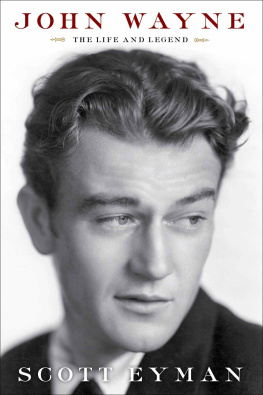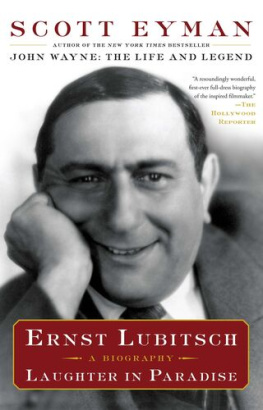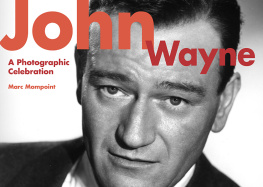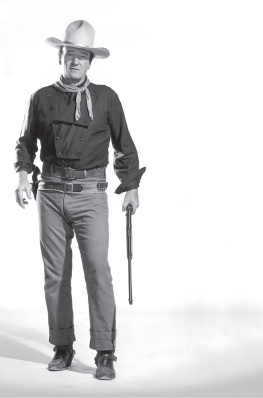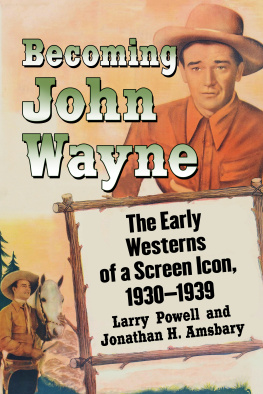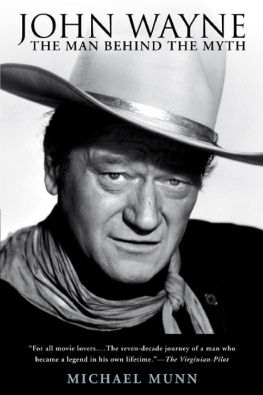Thank you for downloading this Simon & Schuster eBook.
Join our mailing list and get updates on new releases, deals, bonus content and other great books from Simon & Schuster.
C LICK H ERE T O S IGN U P
or visit us online to sign up at
eBookNews.SimonandSchuster.com
CONTENTS
For Jeff Heise
And for Harry Carey Jr.,
Who said,
Just put on my tombstone, He rode with the Duke.
Ride away...
That guy you see on the screen isnt really me. Im Duke Morrison, and I never was and never will be a film personality like John Wayne. I know him well. Im one of his closest students. I have to be. I make a living out of him.
DUKE MORRISON, AKA JOHN WAYNE, 1957
Other people, so I have read, treasure memorable moments in their lives: the time one climbed the Parthenon at sunrise, the summer night one met a lonely girl in Central Park and achieved with her a sweet and natural relationship, as they say in books. I too once met a girl in Central Park, but it is not much to remember. What I remember is the time John Wayne killed three men with a carbine as he was falling to the dusty street in Stagecoach.
THE MOVIEGOER, WALKER PERCY

John Wayne, with the customized, sawed-off Winchester he twirls in his introductory shot in Stagecoach.
PROLOGUE
T he scene had a problem, and the problem was the gun.
Dudley Nicholss script was specific: There is the sharp report of a rifle and Curly jerks up his gun as Buck saws wildly at the ribbons.
The stagecoach comes to a lurching stop before a young man who stands in the road beside his unsaddled horse. He has a saddle over one arm and a rifle carelessly swung in the other hand... It is Ringo...
RINGO. You might need me and this Winchester. I saw a coupla ranches burnin last night.
CURLY. I guess you dont understand, kid. Youre under arrest.
RINGO (with charm). I aint arguing about that, Curly. I just hate to part with a gun like this.
Holding it by the lever, he gives it a jerk and it cocks with a click...
John Ford loved the dialogue, which was in and of itself unusual, but the introduction of the Ringo Kid needed to be emphasized. Ford decided that the shot would begin with the actor doing something with the gun, then the camera would rapidly track in from a full-length shot to an extreme close-upan unusually emphatic camera movement for the period, and an extremely unusual one for Ford, who had grown to prefer a stable camera.
Since the actor was already coping with two large props, Ford decided to lose the horse. He told his young star what he was planning to do: Work out something with the rifle, Ford said. Or maybe just a pistol. He wasnt sure.
And just like that the problem was dropped in the lap of his star, a youngbut not all that youngactor named John Wayne, better known to Ford and everybody else as Duke.
Wayne ran through the possibilities. Every actor in westerns could twirl a pistol, so that was out. Besides, the script specified a rifle cocked quickly with one hand, but later in the scene than what Ford was planning. In addition, Ford wanted him to do something flashy, but it couldnt happen too quickly for the audience to take it in. All the possibilities seemed to cancel each other out.
And then Yakima Canutt, Waynes friend and the stunt coordinator on the film, offered an idea. When Canutt was a boy he had seen Buffalo Bills Wild West show. As the overland stage raced around the arena, a messenger trailing behind the stagecoach had carried a rifle with a large ring loop which allowed him to spin the rifle in the air, cocking it with one hand. The crowd went wild. Canutt said that it had been thirty years ago and he still remembered the moment. More to the point, he had never seen anybody else do it.
Wayne sparked to the idea, as did Ford, but first they had to make it work. Ford instructed the prop department to manufacture a ring loop and install it on a standard-issue 1892 Winchester carbine. After the rifle was modified, Wayne began experimenting with the twirl move as Canutt remembered it, but there was a problemthe barrel of the rifle was too longit wouldnt pass cleanly beneath Waynes arm.
The Winchester went back to the prop department, where they sawed an inch or so off the end, then soldered the sight back on the shortened barrel.
With that minor adjustment, the move was suddenly effortless. Wayne began rehearsing the twirling movement that would mark his entrance in the movie he had been waiting more than ten years to makea film for John Ford, his friend, his mentor, his idol, the man he called Coach or, alternatelyand more tellinglyPappy.
With any luck at all, hed never have to go back to B westerns as long as he lived.

Its the late spring of 1939, and youre sitting in a theater watching Stagecoach. Its a western, not the most admired genre, and the cast is made up mostly of reliable character actors. But the reviews have been more than good, and John Ford has already achieved a measure of fame among critics and moviegoers.
The first couple of minutes have already told you this is a movie made by filmmakers at the top of their gameprecise, emphatic compositions, perfect editing that never leaves a shot on-screen for less time than it needs to be understood, unforced exposition that expertly delineates seven major characters inside of twelve minutes.
The story is basic. Seven strangers are crowded into a stagecoach, leaving a town called Tonto, heading through Indian territory to a town called Lordsburg. The seven people are traveling for seven different reasons, and the characters are deliberately contrasted in a way that goes beyond local color. A whore has a counterpart in a mousy, pregnant military bride; a pompous banker is balanced by a shady, dangerous gambler who can accurately gauge everybodys bad character, especially his own. Likewise, there is a meek little whiskey salesman who has to fend off a raucous alcoholic doctor.
There is also a sheriff, a bluff, hearty man who seems to believe in appearances. And there is one other character we are told about but dont immediately meet: an outlaw lurking somewhere out there, beyond Tonto, beyond civilization. He has escaped from jail, and he too needs to get to Lordsburg, for a private mission of revenge, a mission that the sheriff has pledged to prevent.
This collection of balanced opposites, the respectable confronted with the disreputable, populate the stagecoach, the vehicle through which John Ford will assert the moral equality of the outcast and restate his claim for the western as the seminal American film genre.
The picture is eighteen minutes old when we finally meet the Ringo Kid. There is a gunshot off-camera, there is a location shot of the stagecoach quickly pulling up. Cut to a tall, lean man standing against a process background of Monument Valley with a saddle draped over one arm and a rifle in his other hand. The camera rushes in as he twirl-cocks the rifle with one hand.
If you look at the rifle, it seems to be a tiny bit short, but nobody has ever looked at anything but the actors face. Midway through the cameras rapid track-in, it loses focus for a half a second, then comes to rest in a huge, sharp close-up.

